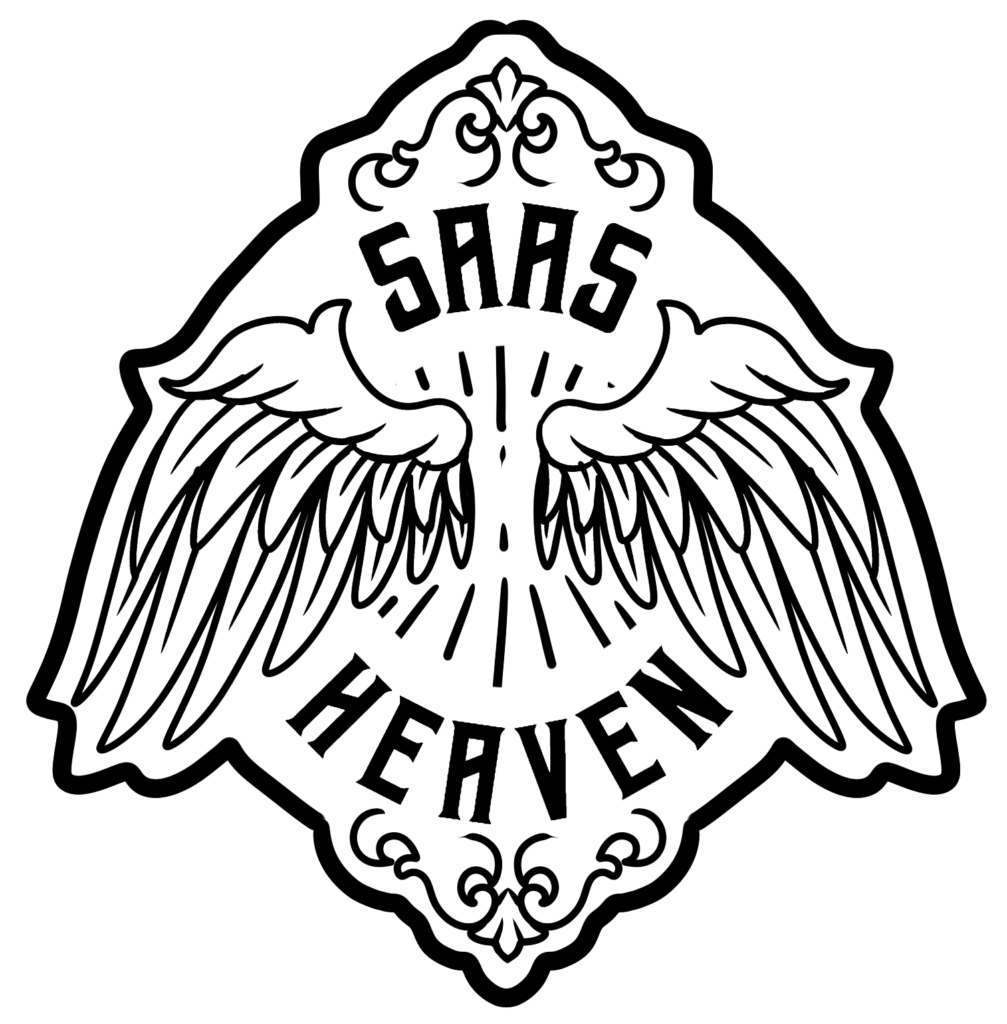Navattic Product demo review

Navattic is the product of former sales and software engineers who know and have experienced the pain points surrounding the provision of hands-on access to the product during the procurement phase.
Built on the belief that the future is product-led, Navattic aims to give companies the ability to use their products as a primary growth driver. The platform cuts out the traditionally expensive engineering resources needed to demo, making it so that customer-facing teams can easily share interactive product demos with users.
Clearly, Navattic is doing something right since it is used by teams in startups and enterprises that include Intuit, Informatica, Citrix, WNDRVR, Fivetran, Demandbase, Help Scout, and more.
-
Product Demo - 89%89%
-
Editing and Customization - 90%90%
-
Integrations - 89%89%
-
Easy of Use - 87%87%
-
Onboarding Process - 91%91%
-
Customer Support - 88%88%
Summary
Demos, like the ones Navattic enables, can be an essential element of driving product-led growth. They not only lower the cost of gaining clients, but they also remove the conventional sales-led model’s obstacles to expansion.
Navattic is an interactive product tour platform anyone can use to create interactive demos. The main idea behind it, according to McLean, is that buying behavior has come a long way, with buyers wanting to touch and feel the product before they purchase it.
He cites the frustration experienced by enterprise software buyers who can test drive a car, for instance, before buying it but have no easy way of testing software. The solution Navattic offers aims to disrupt the traditional B2B software procurement cycle with its inefficient back and forth by leaning into product-led growth.
In this new format, the product becomes the primary customer acquisition tool instead of telling a potential buyer to wait two weeks to see the product.
As we have mentioned, Navattic is a solution built to simplify how consumer-facing teams deliver demos to their prospects quickly and cheaply, without needing engineers or even coding knowledge.
There are three main things Navattic is built to tackle:
Conversion
Navattic is designed to drive more qualified leads using a new call to action that invites clicks. The novelty and efficiency of an embedded product tour excite prospects and are claimed by the company to increase conversion by 25%.
The demo can be set up in minutes, sent to the prospect, elicit feedback (by integrating with existing CRMs to see which features or tours attract the most leads) and fine-tune the product from that point on.
Engagement
The ability to provide a prospect with the demo on the first outbound email is a great way to engage them and get their attention. Navattic is built to cater to that speed and ensure prospects can see and feel the product, even before a single call is made.
Education
According to a ZenDesk survey, 91% of customers would visit an online education resource if it was easily available and customized for their specific needs.
Customers are so willing to learn and find answers for themselves. Gartner estimates that by 2030, a billion service tickets will be raised automatically by bots available to customers.
Sales Teams
Sales teams no longer have to rely on specialized engineering or product teams to create customized demos in a short time.
Revenue Operations
With Navattic product tours, the RevOps team can bring its functions under the same roof and enable monitoring of what’s available to replicate what works over and over.
Marketing Teams
When marketing teams engage prospects with product demos, it gives them something they can form a connection with, given they get a chance to observe it at work and know what it can do.
Engineering Teams,
Navattic enables engineering teams, where they exist, to tackle demo creation quickly or transfer the entire demo cycle responsibility to sales teams.
To understand how Navattic works, let’s dive into its key features:
-
Capture
The objective for Navattic was always to turn anything that can be run on a browser into a replayable web app that performs as close to the expected experience as possible. Navattic uses HTML and CSS captures to create the application to be demoed.
Teams can create shareable, interactive versions of their apps without needing to code anything and all from a Chrome extension or the web app provided by the firm. Navattic’s approach is two-pronged and includes:
- Serializing network requests using a cache.match() with fuzzy matching on edge.
- Serializing the DOM state by hacking CSS, inlining values, patching Web APIs, and more.
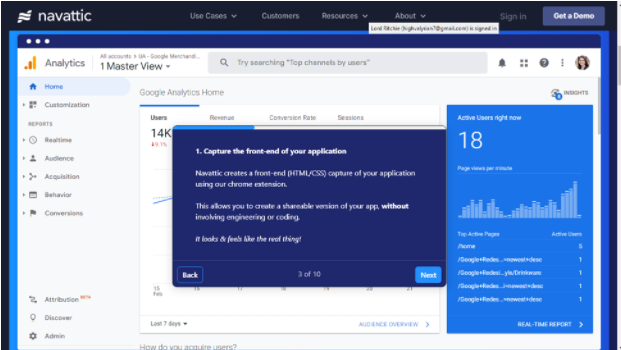
Because Navattic relies on serializing the DOM state, it is language and framework agnostic, which is how it enables implementation without needing engineering teams.
-
Overlay Guides
After the capture, teams using Navattic can annotate their app or tour with prompts and explanations that call attention to the best features of the software/app being shown.
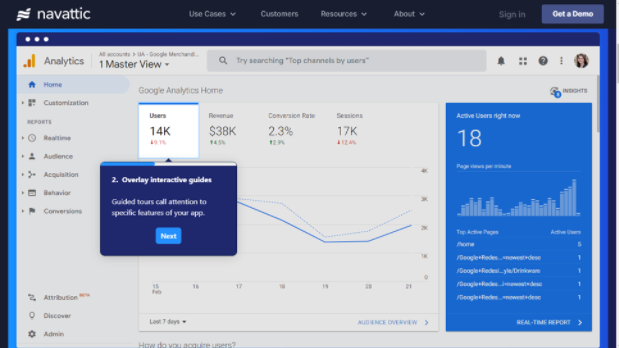
-
Customize
The screen captures can be fully customized with images and text without involving code. The feature is helpful to tweak the demo after feedback or during the conception stage so that it presents to the prospect a product as close to what they need as possible.
For instance, you can blur the images or texts using the editor instead of having to retake the captures.
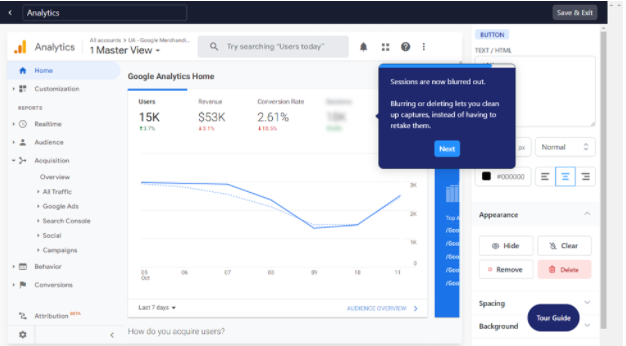
After editing and polishing the demo to the desired level, it can be shared via email or embedded directly on the website.
You can also sync the data to a CRM, so the reps have access prior to making sales calls.
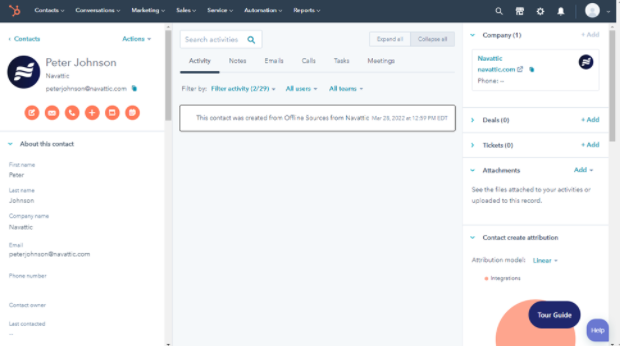
An example of a finished app, as shown by Navattic, looks like this:
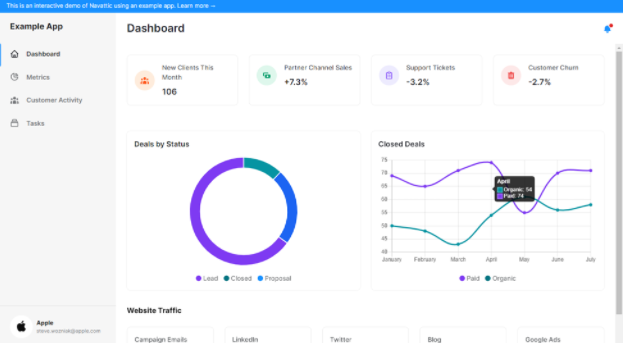
From here, one can access the dashboard to check on the overview, look at metrics for analysis, confirm customer activities, and even schedule tasks.
Does It Have a Native Meeting Platform?
![]()
Navattic does not have its own native meeting platform. However, since it integrates with most of what teams use in their workflows, they can opt to use it in tandem with a meeting platform of their choice.
Deployment, Onboarding, Training, and Support
To get access to and deploy the Navattic platform, one has to get in touch with the folks at Navattic.
There is a simple way to schedule a meeting on the Navattic website. Simply click on ‘Get a Demo’, and you’ll be guided to a dialogue where you fill in your name, work email, and company size, then click on ‘Schedule Time.’
After that, prospects get an email informing them of when the meeting will be. The meeting is a way for Navattic to get to know who will be using the demo and help them know how they can get the most out of it, depending on the end goal.
The onboarding process at Navattic can take anywhere from 2 to 4 weeks. During the product onboarding process, Navattic takes the time to guide customers through the building, reviewing, launching, and enjoying continued success with the demo building platform.
The onboarding process enables the teams to:
- Mutually agree on the steps to take, as well as crucial objectives
- Be set up to enjoy additional and continued value from the platform
- Easily repeat the process for every project they have
- Access the documentation and resources needed in one place
The training and support part of the process is not too separate from the meeting, the deployment, and onboarding. After a new user signs in, Navattic introduces them to what they can do during the kickoff call.
The prospective customers can check out the timeline and milestones with an open invitation to contribute and collaborate on what the details of the demo are going to be.
Integrations
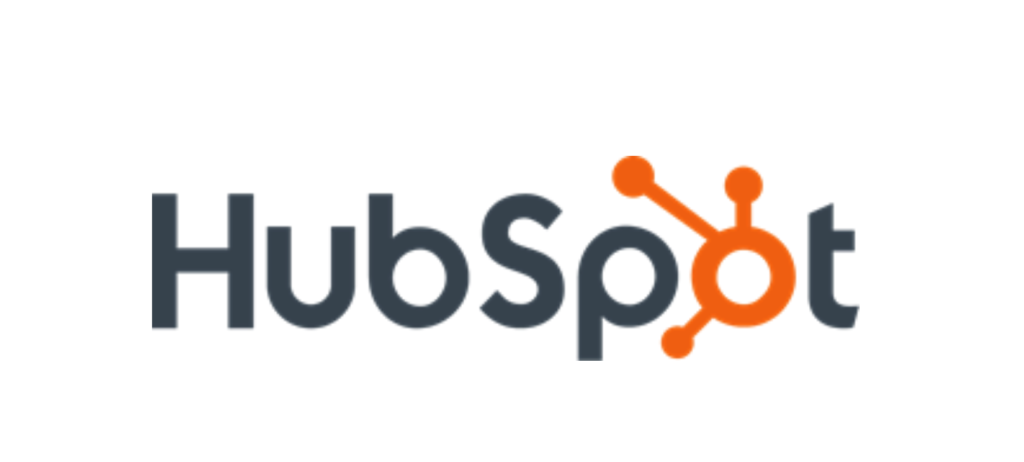
Navattic integrates with several productivity and enterprise tools to enable communication and augment its features with more than what it offers. The integrations include:
- Intercom
- Slack
- HubSpot CRM
- Adobe Marketo
- Salesforce
- Zapier
On its official website, Navattic says that it integrates with your existing stack, eliminating worries that it may not work with what you already have and are used to.
Info About The Company
Navattic was founded in 2020 and is headquartered in San Francisco, California. It was founded by Neil McLean, Chris Hoyle, and Randy Frank and remains a venture capital-backed, privately held company at the time of writing this review.
Navattic is billed as a platform for sharing product demos that assists SaaS sales and marketing teams to create shareable product demos.
The company’s platform automatically saves, organizes, and discovers pre-sales demos, workshops, and proof of concepts, as well as transforming an application into an immersive story with product tours, allowing companies to share access with their prospects and therefore connect early with the target market.
Pricing and Offerings
There is no pricing set for Navattic at the time of writing this review. The company doesn’t have a free trial or freemium model in place. For pricing details, potential users can call the company or schedule a meeting on the official website to get the details and access the tool to test it.
Learning Curve
One of the main selling points used to sell Navattic is that it is easy to use. The SaaS and success teams it is intended for will have no trouble learning how to use it once they get the hands-on experience during the meeting with Navattic representatives.
The platform’s demo building capabilities are entirely codeless and do not require the users to learn anything too technical or too different from processes they’re already used to. The fact that the SaaS sales teams can make the demos on their own without needing engineers to do it speaks to the ease of use and hence should not have too steep a learning curve.
Navattic’s main throughline is simplicity. This ethos is reflected in the user experience and user interface, which are designed to take the users on a journey that ends with a done demo and make it easy for them to find their way around while making the demo.
Navattic’s interface is simple and not crowded, making every element easy to see, find and use. There are clear labels and documentation to help users discover more about the platform.
The color scheme is consistent throughout the platform, ensuring that visuals can be used to direct attention away from or towards the elements the users are meant to employ. The experience on Navattic is built to feel simple in both form and function, which it succeeds in doing.
Not to put too fine a point on this point, but, Navattic is simple. The quest to remove engineering teams from the equation to cut down on how long it takes to craft a demo and be ready to show it is what makes Navattic stand out.
Apart from being codeless, Navattic is fast, taking as little as 30 minutes (depending on the size of the demo) to create the no-code product tour, a very valuable advantage to have in the fast-moving and competitive SaaS market.
The customizability factor is also a point in Navattic’s favor. It allows the user to create product tours geared for each audience, market segment or individual, making it one of the best and easiest to adopt product-led approaches.
In addition to all that, product tours created with Navattic are trackable, letting you know which steps the user has taken. Video products may be flashy and cool-looking but don’t offer that same level of visibility.
Navattic is also interactive, giving the products a more realistic look and letting the product do all the talking instead of relying on overproduced content.
Pros
- The solution increases leads.
- Customers can experience what the product feels like without needing someone to show them.
- The demos save time and expenses for sales teams.
- Customers have fewer issues with the product offered after buying it, given the hands-on experience it provides beforehand.
- There is an option to get analytics that improves future demos, as well as Navattic itself.
- The platform is integral to time-saving efforts and product-led growth.
Cons
- Navittic does not share its pricing information.
- The SaaS demo will present only the information prepared in advance since it is not a live demo.
- Although it is quite easy to use there is still a learning curve
- If embedded, there is always the risk that competitors will see the product using the demo. However, if customers want access to the product, it won’t take long to get access.
- Customers may want to see a demo with their data, given that Navittic’s product tours are front-end captures that don’t have actual customer data besides what is provided. Nonetheless, some product tours can be customized for each client manually, so they appear to display the right customer data.
In today’s SaaS world, end-users typically decide who wins. They are more inclined to pursue solutions on their own and inform their superiors about the ones to consider. By adopting product-led growth, the top software firms have adapted to this market transition and put it into the core of their strategy.
Demos, like the ones Navattic enables, can be an essential element of driving product-led growth. They not only lower the cost of gaining clients, but they also remove the conventional sales-led model’s obstacles to expansion.
We think Navattic has the potential to change how SaaS operations show off what they have to their prospects.
